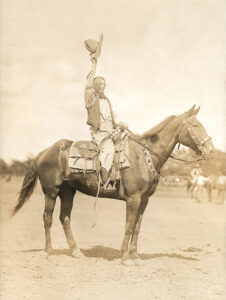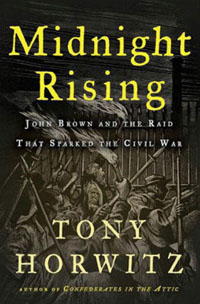 Midnight Rising: John Brown and the Raid That Sparked the Civil War by Tony Horwitz (Henry Holt, 2011, $29)
Midnight Rising: John Brown and the Raid That Sparked the Civil War by Tony Horwitz (Henry Holt, 2011, $29)
Tony Horwitz is one of today’s keenest commentators on the American character. In Midnight Rising, he turns his intuitive eye and sophisticated pen to exploring one of the pivotal and most controversial events in our nation’s history, taking us on a long and strange journey into the dark psyche of “Captain” John Brown and his dedicated company of men as they waged a deeply personal war for the soul of America in the contentious decade preceding the Civil War.
The story of Brown’s October 1859 raid on the federal arsenal at Harpers Ferry, Va.—an ill-conceived attempt to free the nation’s slaves—has been told many times before. But Horwitz’s aim here is not to uncover heretofore undiscovered facts or to ideologically label Brown an angel of freedom or an arch-fiend of terrorism; he wisely leaves that difficult decision to the reader. Rather, Horwitz wants to get inside the heads of Brown and his men, most of whom led ordinary lives before embarking on this extraordinary crusade.
Besides the well-known raiders like Dangerfield Newby and Brown’s sons Owen, Oliver and Watson, Horwitz deftly paints word pictures of men whose names rarely grace the pages of history books: one-time schoolteacher John Henry Kagi, Brown’s second-in-command; Lewis Leary and John Copeland, both born into slavery but then living free in Ohio; William Leeman, a shoe factory worker from Maine; and Albert Hazlett, like Brown a veteran of the bloody Border Wars in Kansas. He also highlights the important roles played by Brown’s daughters, Martha and Annie, in the days before the raid, when the conspirators were confined to the buildings of the Kennedy Farm, a few miles from Harpers Ferry.
Horwitz makes extensive use of the letters written by various members of the Brown family. They, too, are eloquent storytellers, and Horwitz wisely allows their voices to carry much of the narrative. From them we learn about Brown’s fiercely held moral and religious convictions, beliefs he acted upon boldly and without fear throughout his life. Unlike most whites of his era, Brown also harbored no taint of racism. He not only wanted blacks to be free, he wanted them to be equal in educational opportunities, voting rights and the ownership of property and businesses.
Through the years, many have speculated on whether Brown was not only crazy but also a psychopath. Horwitz portrays a man utterly sane who realized he could achieve his goals by dying more than he could by living. Throughout the war, his “soul” served as a touchstone for the Union cause and rallied many failing hearts during its darkest days.
The fire bell in the night struck by Brown and his men could not be un-rung and, as he prophesied from the shadow of his gallows, the sins of his troubled land would not be purged except with blood. The echoes of Brown’s act of patriotic treason still resonate as we struggle with the profound issues of race, freedom, patriotism and moral courage.
—Gordon Berg
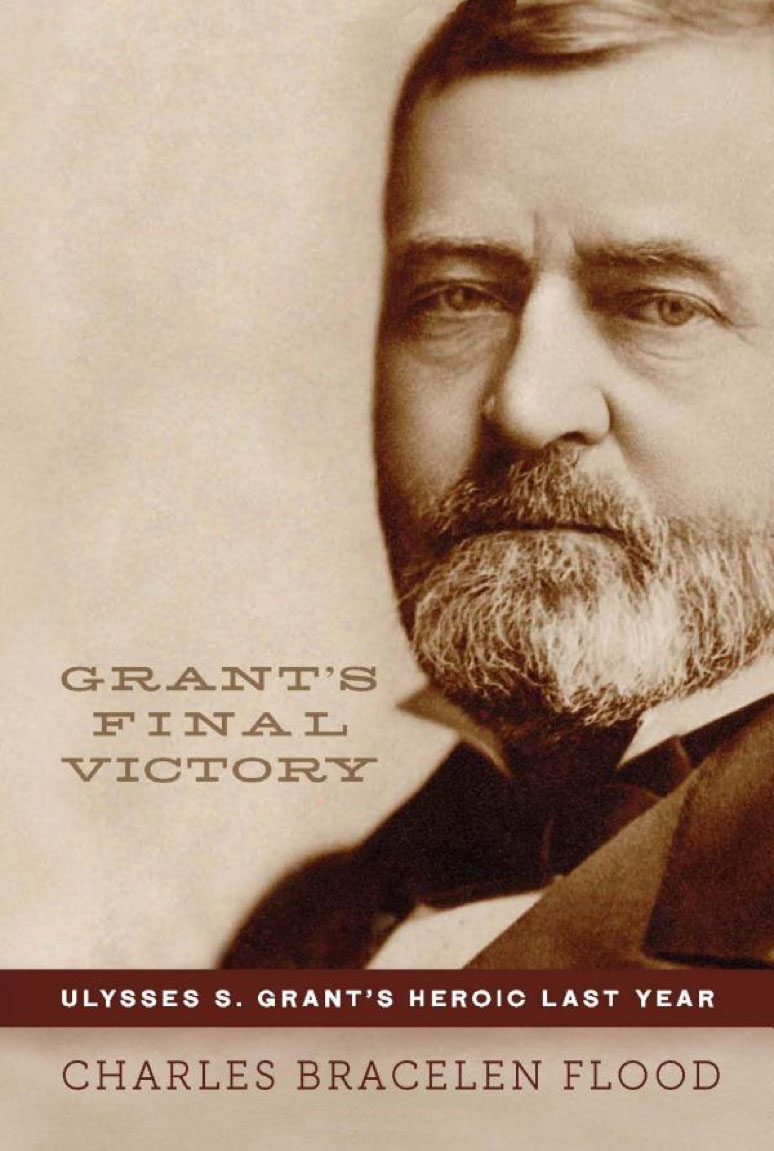 Grant’s Final Victory: Ulysses S. Grant’s Heroic Last Year by Charles Bracelen Flood (Da Capo Press, 2011, $27.50)
Grant’s Final Victory: Ulysses S. Grant’s Heroic Last Year by Charles Bracelen Flood (Da Capo Press, 2011, $27.50)
Post-war memoirs tend to be written by vanquished veterans offering explanations for why they lost a particular conflict. In Ulysses S. Grant’s memoirs, however, we see a war winner and former president of the United States who late in life lost just about everything. On May 6, 1884, the Grant & Ward Company and the Marine Bank collapsed, sending Grant’s partner, Ferdinand Ward, and Marine Bank president James D. Fish to prison for a number of financial irregularities and leaving Grant himself, as senior partner, destitute. In the fall, the former commander in chief was diagnosed with throat and mouth cancer; afraid of leaving his family in dire financial condition, Grant raced to finish his two-volume book. It is this period Charles Bracelen Flood examines in Grant’s Final Victory, ending with Grant’s death and funeral.
The author describes step-by-step the titanic struggle Grant underwent to finish his book. Even a drink of water was torture for him, although he tried to hide it from his wife and his children. Because he had lost his military pension when he became president and Congress hesitated to vote him a renewed pension after his financial disaster (it was finally ratified, but too late), Grant had to depend on sympathetic individuals for money. The first to provide it, hitherto unknown to him, was Charles Wood of Lansingburgh, N.Y., who had fought under him; the second was Mattias Romero, Mexican ambassador to the United States, who had worked closely with Grant in planning a railroad line from Mexico City to Guatemala.
Flood furnishes his book with highlights in Grant’s career, such as the surrender of Robert E. Lee’s Army of Northern Virginia at Appomattox, when Grant magnanimously permitted Lee’s officers, cavalrymen and artillerymen to keep their horses to use on their farms. In 1884, as the ailing Grant was writing seven hours a day to finish his book, a letter came from former Rebel A.M. Arnold of Rockbridge Baths, Va.: “Dear General, I have watched your movements from the hour you gave me my horse and sword and told me to go home and ‘assist in making a crop’—I have been proud to see the nation do you honor.”
Flood, author of The Last Years of Grant and Sherman, succeeds in explaining the role that Grant’s memoirs, completed just four days before his death, played in reuniting the nation. He makes a minor error in Chapter 6 when he attributes the phrase “the only good Indian is a dead Indian” to Lt. Gen. William T. Sherman, but aside from that quibble Grant’s Final Victory is a top-notch book on an important moment in American history.
—Thomas Zacharis
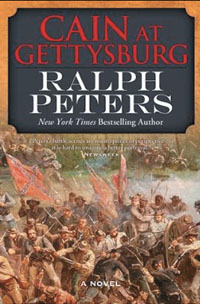 Cain at Gettysburg by Ralph Peters (LSU Press, 2011, $34.95)
Cain at Gettysburg by Ralph Peters (LSU Press, 2011, $34.95)
Civil War fiction always faces the challenge of authenticity. Ralph Peters, author of The War After Armageddon, now takes up this challenge in his new book Cain at Gettysburg.
Unafraid of historiographical niceties, Peters takes us inside the minds of Gettysburg’s mythical giants—Confederate General Robert E. Lee and the Army of the Potomac’s newly named commander George Gordon Meade, among others—and exposes the imagined warts and deep inner thoughts and anxieties. As with more traditional Civil War fiction, Peters also has a cast of minor created characters who fill the ranks and join the charges, and through which we see the horror of combat as the author interprets it. Peters’ direct and likely controversial interpretation of the perspectives of the major historical characters, however, sets his work apart from many fictional accounts of the war’s most important battle, even works like Michael Shaara’s 1974 masterpiece The Killer Angels.
Peters’ prose is stark, clipped and occasionally supplemented with curious metaphors. His battle scenes are gruesome and detailed, sparing the reader no information that might help convey the horrors of combat: Think The Red Badge of Courage meets Stephen King.
Still, this is a risky venture for Peters. He could be dismissed by those with enough historical training to question his interpretations, while also breaking conventions that might otherwise make Cain at Gettysburg comparable to other popular and critically acclaimed Civil War fiction—Cold Mountain, for instance—or to phenomenological novels such as Andersonville.
Readers will have to determine for themselves whether they are willing to suspend their disbelief and enter the smoke-filled haze of America’s most famous military killing ground with Peters. They may come away horrified, and filled with questions about what really happened, but that is perhaps what the author intends.
—Jack Trammell
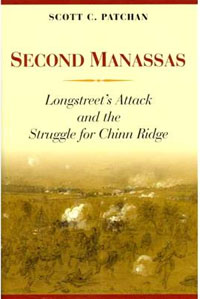 Second Manassas: Longstreet’s Attack and the Struggle for Chinn Ridge by Scott C. Patchan (Potomac Books, 2001, $26.95)
Second Manassas: Longstreet’s Attack and the Struggle for Chinn Ridge by Scott C. Patchan (Potomac Books, 2001, $26.95)
John J. Hennessy did such a magnificent job examining the Second Manassas Campaign in his 1993 book Return to Bull Run that most aficionados were probably convinced there just wasn’t anything else to say about the Army of Northern Virginia’s nadir moment. Fortunately, with this new book Scott Patchan proves that isn’t the case.
In providing a welcome look at the brutal struggle for Chinn Ridge and Henry Hill on the afternoon of August 30, 1862, Patchan makes clear the Confederates had an all-too-rare opportunity to effectively destroy a major field army with one fell swoop. That this moment existed was the result of a colossal blunder by Union General Irvin McDowell. That the Confederates did not fully seize the opportunity, Patchan explains, was due to hard fighting by the Union soldiers defending Chinn Ridge and Henry Hill, the commendable response to the crisis by the army’s commanders, and a sequence of minor Confederate tactical errors.
This is a worthwhile study. Patchan effectively chronicles and analyzes the critical command decisions that shaped the fighting and the men who made them. He also does a fine job explaining the effect of terrain on the battle, draws on a solid research effort to describe and explain the experience of the men who fought on both sides, and provides a useful guide to the battlefield in an appendix. Readers with an interest in Second Manassas and micro-tactical studies in general will find much of value here, especially those who enjoy walking the battlefields of America’s bloodiest war.
—Ethan S. Rafuse




